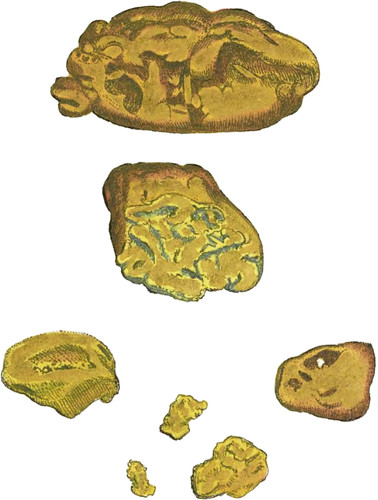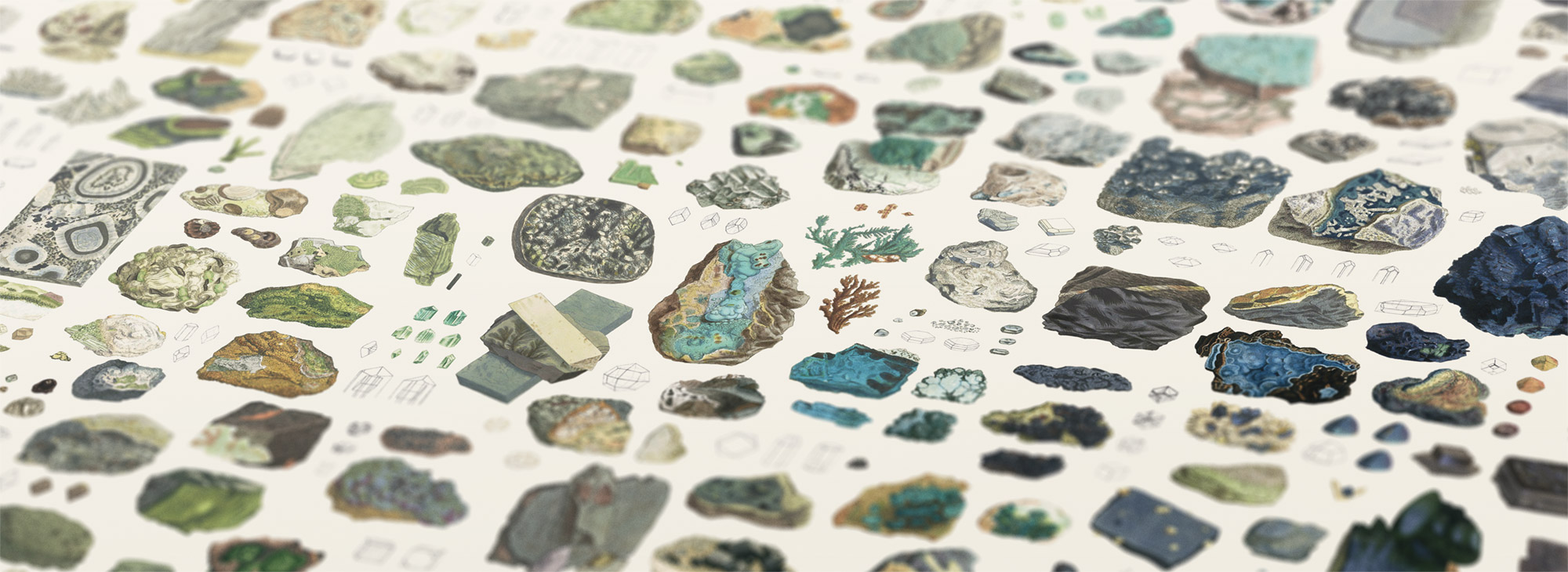 Enlarge
Enlarge
British Mineralogy
Native Gold
- Class 3. Metals.
- Ord. 1. Homogeneous.
- Gen. 2. Gold.
- Spec. 1. Native.
- Div. 3. Amorphous.
- Gen. Char. Malleable, sonorous, reddish yellow, Spec. Grav.
- Spec. Char. Uncombined.
- Syn.
- Native gold. Kirw. 2. 93. Phil. Trans. 1796. p. 45.
- Aurum nativum. Waller, t. 2. p. 355.
- Gediegen gold. Emmerl., t. 2. p. 111.
- Or nativ. Haüy 3. 374.
- Aurum nativum. Linn. Syst. ed. 13.
Gold is well known to be found in Peru, several parts of the East Indies, and Hungary, often crystallized in octaëdrons and their modifications. It has also been found in Scotland. We have specimens from Cornwall and Ireland. We received a letter from Dublin, dated Oct 24th, 1795, which relates some curious facts that may worth mentioning here. “It is strongly maintained in the antient Irish records, that in the courts of their kings and residences of their great men, an extraordinary magnificence was once displayed. That they feasted and drank out of vessel of gold, used it for armour, ornaments of dress, &c. In an age when navigation, and therefore commerce, were circumscribed, it is concluded, that the gold must have been found in the country. Those who doubt this judge from the disregard that has been invariably shown by the foreign settlers in this country to its mineral productions. They preseume that it could not have escaped their avarice or their skill, if any thing of the kind worth regarding existed here, and they maintain that the gold must have been procured somewhere from abroad. A recent transaction has shown that there is probably much gold in this country not many miles from this city. The people of its neighbourhood have long been acquainted with it, and from time to time sold native gold to the silversmiths, but woudl not tell where they found it. A late disagreement about the division of their treasure caused a discovery. A stream descending from a mountain* runs along a valley at its foot: in the sand of this stream and the sand of the valley on either side are found lumps of native gold.” Pieces have been found weighint 22 oz.; but they are generally much smaller, from 3 ounces to a few grains. It is said some families were in the constant habit of procuring it†. Endeavours have lately been made to discover the mine, but, as far as we yet know, to no purpose.
The upper specimen was lent me by Sir. J. Banks, who bought it of an Irishman who brought some to London to sell to the curious; and this was one of his largest specimens. It is formed of flattish pieces, or lamellated, as if it had been rolled up and beaten about very irregularly, as Sir. J. Banks truly remarks, so that it may be called entirely shapeless. It was cut in two at the mint, which helped to discover this foliated appearance; and also, that it contained grains of whitish quartz and an ochraceous gritty clay (see the cut figure). A piece of soft lightish schistus, or slate, with a gray appearance on the inside is to be seen in it. The external colour is somewhat redder than where it is broken or cut. Mr. Blackford kindly sent me a piece somewhat paler.
The third figure on the right hand was a piece of a redder cast; that on the left hand was the whitest of any I have seen from Ireland. These two were purchased for me by my friend Colonel Velley.
The three lower pieces are different coloured specimens, from Lammon tin stream, near Falmouth, in Cornwall. Gold is much more scarce in Cornwall than in Ireland. The Irish specimen spoken of in Phil. Trans. was found to contain
| Of Fine Gold | 21688 |
| Fine Silver | 17/8 |
| Alloy Copper and Iron | 03/8 |
| 24 |
Other specimens differ a little; and thus, if we may judge by the outer aspect, the reddest probably contains most copper and iron, and the whitest most silver. More silver seems to give a greenish tinge to gold: the little lowest left-hand figure has that tinge.
- * Mount Croaghan near Arklow in the county of Wicklow.
- † We have been told that lumps of gold of a large size have been till lately used as weights in some of the common shops, and others placed to keep their doors open, in some parts of Ireland, the owners not knowing what they truly were.

